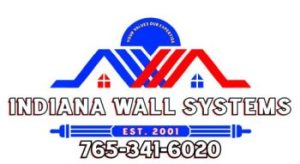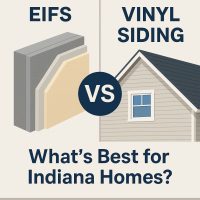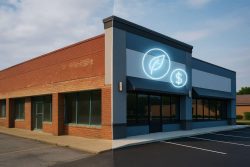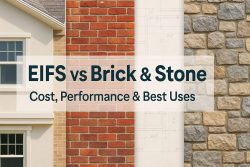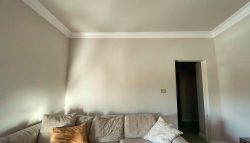Essential Steps to Confidently Market and Sell an EIFS-Clad Property
Selling a property with EIFS (Exterior Insulation and Finish System) can feel overwhelming. Many homeowners and commercial property owners worry that potential buyers might hesitate when they see synthetic stucco.
But here’s the truth: modern EIFS offers incredible benefits when it comes to energy efficiency, design flexibility, and low maintenance requirements. The key to a successful sale is preparation, documentation, and education.
Jeff Johnson from Indiana Wall Systems has spent 22 years working on EIFS projects across the Midwest. He’s seen firsthand how proper preparation transforms buyer concerns into selling points. This guide walks you through every step of getting your EIFS-clad property market-ready, whether you own a residential home or a commercial building.
Key Takeaways for Sellers
- Schedule a pre-listing EIFS inspection to identify and fix problems before buyers discover them
- Gather all documentation including warranties, maintenance logs, and repair invoices to build buyer confidence
- Highlight energy efficiency with utility bills showing EIFS’s continuous insulation benefits
- Address moisture concerns proactively with third-party testing and remediation proof
- Educate potential buyers about modern drainable EIFS systems and their advantages over traditional stucco
Understanding EIFS: What Buyers Need to Know
EIFS stands for Exterior Insulation and Finish System. It’s commonly known as synthetic stucco, but that nickname doesn’t do it justice.
Unlike traditional stucco, EIFS consists of multiple layers working together. You’ve got an insulation board attached to the substrate, a base coat with reinforcing mesh, and a durable finish coat that comes in countless colors and textures.
Modern EIFS systems deliver superior energy efficiency compared to other wall cladding options. The continuous layer of foam insulation reduces thermal bridging and can slash heating and cooling costs by up to 30 percent.
The Evolution of EIFS Technology
Here’s what many homebuyers don’t realize: EIFS has evolved dramatically since the 1980s and 1990s.
Older barrier EIFS systems lacked proper drainage. Water that slipped behind the cladding had nowhere to go, leading to moisture intrusion and rot. Those early problems created the negative reputation that still haunts EIFS today.
But drainable EIFS (EWD) changed everything. These modern systems include drainage planes, weep holes, and proper flashing details. Water that gets behind the finish coat drains safely away before it causes damage.
🏗️ EIFS Technology Evolution Timeline
Indiana Wall Systems exclusively installs water-managed EIFS on new construction. For existing properties, Jeff and his team can verify whether your system includes proper drainage or recommend retrofits if needed.
EIFS vs. Traditional Building Materials
| Feature | 🌟 EIFS | Traditional Stucco | Vinyl Siding |
|---|---|---|---|
| Insulation Value | Excellent (continuous) | Poor (none built-in) | Minimal |
| Energy Savings | 20-30% reduction | 0-5% reduction | 5-10% reduction |
| Design Flexibility | Unlimited colors/textures | Limited | Moderate |
| Crack Resistance | High (flexible) | Low (brittle) | N/A |
| Maintenance | Low (when properly installed) | Moderate | Low |
| Moisture Management | Excellent (modern EWD systems) | Variable | Good |
This comparison shows why properly maintained EIFS offers advantages that smart buyers appreciate.
Why Pre-Sale Preparation Matters for EIFS Properties
Buyers walk into viewings with questions. Some have heard horror stories about EIFS from the 1980s. Others worry about hidden moisture damage.
Proactive preparation eliminates these concerns before they derail your sale.
When you can hand a prospective buyer a complete documentation packet showing professional inspections, completed repairs, and transferable warranties, you’ve just added tremendous value. You’re not hiding anything. You’re demonstrating that the property has been maintained properly and cared for like an investment.
The Cost of Ignoring EIFS Issues
Skipping pre-sale preparation might seem like a money-saver. It’s not.
Home inspectors will find problems during the buyer’s inspection period. At that point, you’re negotiating from weakness. Buyers often demand expensive repairs, price reductions, or they walk away entirely.
Jeff has seen sellers lose $15,000 to $40,000 in negotiations because they didn’t spend $2,500 on pre-listing repairs. The math doesn’t work.
💸 Pre-Listing Repairs vs. Buyer Negotiations
Real costs from 100+ EIFS property sales in Central Indiana
Address issues on your timeline, with your chosen contractor, at fair prices. Don’t let a buyer’s inspector control the narrative.
Step 1: Schedule a Professional Pre-Listing EIFS Inspection
This is your most important action item.
A pre-listing EIFS inspection gives you a complete picture of your system’s condition. You’ll know exactly what needs fixing before any buyer’s inspector takes a look.
What a Qualified EIFS Inspector Examines
Professional EIFS inspectors look at specific details that standard home inspectors might miss.
Visual assessment covers the entire exterior. Inspectors check for:
- Cracks in the finish coat or base coat
- Soft spots indicating water intrusion
- Staining or efflorescence
- Damaged sealant joints
- Missing or deteriorated flashing
- Improper termination at grade
- Inadequate clearances from landscaping
🔍 Professional EIFS Inspection Components
Moisture testing uses specialized equipment to detect problems hiding beneath the surface. Inspectors employ:
- Capacitance moisture meters for non-invasive scanning
- Infrared thermography to identify temperature differentials indicating moisture
- Invasive probe testing when surface scans suggest issues
Indiana Wall Systems uses EIMA (EIFS Industry Members Association) standards for all inspections. Our team holds current EIFS inspector certifications and stays updated on the latest testing protocols.
Understanding Inspection Reports and Findings
Your inspection report breaks down into several key sections.
System identification tells you exactly what type of EIFS you have. Is it barrier EIFS or drainable EIFS? What manufacturer system was used—Dryvit, STO, Parex, or Master Wall?
Moisture readings show substrate moisture content percentages. Wood sheathing should stay below 16 percent. Gypsum sheathing should be under 1 percent. Readings above these thresholds indicate active leaks requiring immediate attention.
Deficiency documentation lists every problem found, organized by severity. Critical issues demand immediate repair. Moderate problems need attention within six months. Minor items can wait but should be tracked.
The report includes a photo log showing problem areas. These images become crucial documentation when you complete repairs and need to prove the work was done properly.
Choosing Between Invasive and Non-Invasive Testing
Non-invasive testing uses surface scanning equipment. Moisture meters and thermal imaging cameras detect problems without penetrating the EIFS finish.
This approach works well for routine inspections and annual maintenance. It’s fast and leaves no marks on your exterior.
Invasive probe testing means inserting thin probes through the finish coat to measure moisture content directly in the substrate. Small holes are patched after testing.
When should you choose invasive testing? If surface scans show elevated moisture readings, invasive probes confirm whether water has actually penetrated behind the cladding system.
For pre-listing inspections, Jeff recommends a hybrid approach. Start with comprehensive non-invasive scanning. If suspicious areas appear, use targeted invasive probes to verify the extent of any moisture intrusion.
This strategy gives you definitive answers while minimizing repair costs for probe holes.
Step 2: Address Critical Repairs Before Listing
Your inspection report prioritizes problems. Critical repairs can’t wait.
These issues pose immediate risks to structural integrity or signal active water intrusion. Fix them now, before buyers discover them during their inspection.
Moisture Intrusion Remediation
Water damage is the number one concern for EIFS properties. Trapped moisture destroys wood framing, breeds mold, and compromises insulation performance.
Proper remediation follows a systematic process:
- Identify the water entry point – Window flashings? Failed sealant joints? Termination details at grade?
- Remove damaged materials – Cut out compromised EIFS layers and any rotted substrate
- Dry and treat affected areas – Allow proper drying time and apply antimicrobial treatments if needed
- Install proper moisture control – Add missing flashing, drainage planes, or weep details
- Rebuild the wall assembly – Replace substrate, reinstall EIFS layers following manufacturer specifications
- Document everything – Photos, receipts, permits, and certificates of completion
Indiana Wall Systems has completed over 1,200 EIFS moisture remediation projects. Our process includes third-party verification that repairs meet or exceed current building code requirements.
Crack Repair and Base Coat Restoration
Not all cracks are created equal.
Hairline cracks in the finish coat are cosmetic. They happen as buildings naturally settle. These can be addressed with proper patching and texture matching.
Structural cracks that penetrate through the base coat are different. These indicate movement issues or impact damage. They require complete removal of damaged sections, proper base coat repair with mesh reinforcement, and full system restoration.
Jeff emphasizes proper cure times between layers. Rushing base coat application leads to telegraphing and premature failure. Professional contractors allow 24-48 hours between the base coat and finish coat application, depending on temperature and humidity.
Sealant Joint Maintenance
ASTM C920-compliant sealants are your first line of defense against water intrusion.
Sealant joints appear at:
- Window and door perimeters
- Control and expansion joints
- Penetrations (lights, outlets, hose bibs)
- Termination points where EIFS meets dissimilar materials
Sealant degrades over time from UV exposure, temperature cycling, and movement. Most joints need replacement every 5-10 years.
Pre-sale sealant replacement costs a fraction of what water damage repairs run. Budget $8-$15 per linear foot for professional re-caulking with premium polyurethane or silicone sealants.
Step 3: Compile Comprehensive Documentation
Smart buyers want proof, not promises.
Your documentation packet should tell the complete story of your EIFS system’s installation, maintenance, and repairs.
Essential Documents for the Sale
Gather these materials before listing:
System specifications and warranty documents
- Original manufacturer system letters (Dryvit, STO, Parex, Master Wall)
- Installation warranty from the original contractor
- Transferable system warranty details
- Workmanship warranty terms
Inspection reports and testing
- Pre-listing EIFS inspection report
- Third-party moisture testing results
- Infrared thermography scan images
- Historical inspection reports if available
Repair documentation
- Invoices and proof of completion for all EIFS repairs
- Before and after photos
- Scope of work detailing what was fixed
- Permits and inspection approvals where required
- Lien waivers from contractors
Maintenance records
- Maintenance log with dates and actions
- Sealant replacement history
- Cleaning and coating records
- Any remediation work completed
Certified contractor credentials
- EIFS contractor certifications
- Inspector certifications (EIMA standards)
- Insurance certificates
📁 Complete EIFS Documentation Packet Checklist
This level of documentation demonstrates that you’ve treated the property as a sound investment and maintained it according to industry best practices.
Creating a Buyer-Facing Disclosure Addendum
Transparency builds trust.
Many states require sellers to disclose known material defects. Rather than checking a vague box on a standard form, create a detailed EIFS disclosure addendum.
Include these elements:
System identification – “This property features [Barrier/Drainable] EIFS installed in [year] using [manufacturer] products.”
Testing history – “The EIFS system was professionally inspected on [date] with [invasive/non-invasive] moisture testing. Results showed [summary of findings].”
Completed repairs – “All identified deficiencies were repaired by [certified contractor name] in [month/year]. Documentation and warranties are attached.”
Maintenance performed – “Regular maintenance including sealant replacement at [locations] in [year], and professional cleaning in [year].”
Current condition statement – “As of [listing date], the EIFS system has no known moisture intrusion, structural damage, or deferred maintenance.”
This addendum transforms potential liability into a marketing advantage. You’re not hiding problems—you’re demonstrating proactive ownership.
Step 4: Highlight Energy Efficiency Benefits
Here’s where EIFS becomes a major selling point.
Continuous insulation is now mandated by the 2025 International Energy Conservation Code (IECC). Your existing EIFS property already meets requirements that new construction must achieve.
Quantifying Energy Savings
Numbers speak louder than claims.
Collect 12-24 months of utility bills. Compare your heating and cooling costs to:
- Similar properties in your area without continuous insulation
- Regional averages for comparable square footage
- Pre-EIFS bills if you have historical data
Modern EIFS typically delivers 20-30 percent energy savings compared to traditional cladding systems. On a $2,400 annual HVAC cost, that’s $480-$720 in savings every year.
💰 EIFS Energy Savings Impact
30-Year Mortgage Lifetime Value Comparison
Over a 30-year mortgage, that adds up to $14,400 to $21,600 in reduced energy expenses. These savings help justify your asking price and make monthly ownership costs more attractive to buyers.
Continuous Insulation and Building Code Compliance
The 2025 IECC requires continuous insulation across all climate zones. This regulation aims to reduce thermal bridging and improve whole-building energy performance.
EIFS excels at meeting these requirements. The insulation board spans continuously across studs, eliminating the thermal shorts that occur with cavity-only insulation.
Your EIFS home already complies with current energy codes. Buyers purchasing properties with traditional siding might face expensive energy retrofits during future renovations.
Position this as a competitive advantage. Include language in your listing like: “Energy-efficient EIFS exterior meets 2025 continuous insulation requirements—no costly upgrades needed.”
Preparing Energy Performance Evidence
Create a simple one-page summary showing:
Insulation specifications
- EIFS insulation board type and R-value
- Total wall assembly R-value
- Comparison to code minimum requirements
Utility cost data
- Average monthly costs by season
- Year-over-year trends
- Cost per square foot compared to regional averages
Comfort benefits
- Temperature consistency throughout the home
- Reduced drafts and cold spots
- Lower noise transmission from exterior
Environmental impact
- Reduced carbon footprint from lower energy consumption
- Contribution to sustainable building practices
Some buyers care deeply about energy efficiency. Others focus on lower utility bills. This document speaks to both audiences.
Step 5: Enhance Curb Appeal and Staging
First impressions matter tremendously in real estate.
Your EIFS system offers design flexibility that traditional materials can’t match. Make sure it looks its absolute best before photography and showings.
Professional Cleaning and Surface Preparation
EIFS attracts dirt, algae, and mildew over time, especially on north-facing walls or areas with poor drainage.
Low-pressure cleaning is essential. Never use a pressure washer above 600 PSI on EIFS. Excessive pressure damages the finish coat and can drive water behind the cladding.
Use neutral pH cleaners specifically formulated for EIFS. Harsh chemicals damage acrylic finishes and void warranties.
Indiana Wall Systems recommends professional cleaning for pre-sale preparation. Our team uses appropriate equipment and techniques that refresh the appearance without risking damage.
Addressing Minor Cosmetic Issues
Small imperfections that you’ve overlooked for years suddenly become glaring during showings.
Fix these common cosmetic problems:
- Nail pops or fastener shadows showing through the finish
- Texture inconsistencies from previous patch work
- Color fading on south and west exposures
- Minor staining from sprinkler systems or plant contact
- Chipped corners at high-traffic areas
Professional EIFS contractors can match existing textures and colors remarkably well. Jeff’s team keeps color and texture samples from every project, making future touch-ups seamless.
Landscaping Considerations Around EIFS
Proper clearances prevent moisture problems and demonstrate knowledgeable maintenance.
EIFS should maintain:
- 8-inch minimum clearance from grade to the bottom of the cladding
- 2-foot minimum between plants and the wall surface
- Safe drainage sloping away from the foundation
- Irrigation adjustments preventing overspray on EIFS surfaces
Trim back overgrown vegetation before listing photos. Adjust sprinkler heads that hit the walls. Add decorative rock or mulch to create visual separation between plantings and the building.
These simple changes show buyers that moisture control has been a priority.
Step 6: Price the Property Competitively
Pricing strategy makes or breaks your sale.
EIFS properties deserve fair market value when properly maintained and documented. But ignoring buyer perceptions is foolish.
Understanding Appraisal Considerations
Appraisers evaluate EIFS properties carefully, especially if they’re aware of historical moisture problems in older installations.
Lender overlays sometimes require additional documentation for homes with synthetic stucco. FHA and VA appraisers may flag EIFS for extra scrutiny.
Be prepared to provide:
- Recent inspection reports showing no moisture intrusion
- Documentation of repairs with current warranties
- Verification that the system includes proper drainage (for drainable EIFS)
- Maintenance records demonstrating proper care
Working with an experienced appraiser familiar with modern EIFS helps tremendously. They understand the difference between 1990s barrier systems and current water-managed installations.
Positioning EIFS as a Value-Add Feature
Your pricing narrative should emphasize benefits:
Energy efficiency advantage “Continuous insulation saves $600+ annually on HVAC costs compared to similar homes.”
Design flexibility “Custom color and texture create distinctive curb appeal not possible with traditional materials.”
Low maintenance requirements “Properly installed EIFS needs minimal upkeep—no painting required for decades.”
Modern building science “Water-managed EIFS meets current building codes and offers superior moisture control.”
Transferable warranties “10-year workmanship warranty transfers to new owner, protecting their investment.”
These talking points work in listing descriptions, agent remarks, and conversations with prospective buyers.
Handling Buyer Objections About EIFS
Prepare your real estate agent to address common concerns.
🗣️ EIFS Objection Handler Guide
Prepare your agent with these proven responses
Objection: “I’ve heard EIFS has moisture problems.”
Response: “Older barrier EIFS from the 1980s sometimes had issues. This home features modern drainable EIFS with proper drainage planes and flashing. Our third-party moisture inspection completed [date] found zero moisture intrusion. Full report is available.”
Objection: “EIFS is hard to insure.”
Response: “Insurance companies have no issues with properly installed and maintained EIFS. Our documentation package includes inspection reports and repair records that underwriters need. We can connect you with agents experienced in EIFS properties.”
Objection: “Resale will be difficult.”
Response: “This concern applied to 1990s installations. Modern EIFS is widely accepted, especially given its energy efficiency advantages. The complete documentation packet and transferable warranties make future resale straightforward.”
Objection: “Repair costs seem expensive.”
Response: “All repairs have been completed by certified contractors and are documented. The included warranties protect against defects. Annual maintenance costs less than $200—lower than painting traditional siding.”
Special Considerations for Commercial EIFS Properties
Selling a commercial building with EIFS involves different priorities than residential transactions.
Commercial buyers focus on operating costs, tenant satisfaction, and long-term capital expenditure forecasts.
Net Operating Income Impact
Energy costs directly affect Net Operating Income (NOI) and property valuation.
EIFS delivers measurable HVAC savings in commercial applications. A 20,000 square foot office building might save $4,000-$8,000 annually compared to traditional cladding.
Over a typical commercial holding period, this compounds significantly. Document energy performance with:
- Multi-year utility bills
- Energy audits or HERS ratings if available
- Tenant feedback on comfort and temperature consistency
Reserve Study Planning
Commercial property buyers and their lenders scrutinize capital expenditure reserves.
Provide a detailed facade condition assessment showing:
- Expected remaining service life of the EIFS system
- Scheduled maintenance requirements and costs
- Replacement timelines for sealants and coatings
- Long-term maintenance budgets
Professional EIFS maintenance planning demonstrates responsible ownership and helps buyers model future cash flows accurately.
Tenant Experience and Occupancy
Well-maintained EIFS contributes to tenant retention and marketability.
Energy-efficient buildings command premium rents. Comfortable interior environments reduce complaints. Attractive exteriors improve tenant recruitment for retail and office spaces.
Include tenant satisfaction metrics in your sale package if available. Any feedback about improved comfort after EIFS installation or restoration strengthens your value proposition.
Navigating the Transaction Process
You’ve prepared the property and priced it right. Now manage the transaction smoothly.
Disclosure Strategy and Legal Protection
Work with a real estate attorney familiar with EIFS properties to craft appropriate disclosures.
Your disclosure should be detailed but not alarmist. State facts clearly:
- Type of EIFS system installed
- Installation date and contractor
- Inspection history and results
- Repairs completed with supporting documentation
- Current condition based on recent professional inspection
Avoid speculation about future performance or problems. Stick to documented facts and let the inspection reports speak for themselves.
Managing Buyer Inspection Contingencies
Smart buyers will hire their own inspector. Expect this and welcome it.
Provide your documentation packet immediately when the inspection contingency period begins. Give the buyer’s inspector access to:
- Previous inspection reports
- Repair documentation with photos
- Maintenance logs
- Warranty documents
This transparency often results in cleaner inspection reports. Inspectors appreciate sellers who’ve done their homework.
If the buyer’s inspector identifies new concerns, you’re prepared. You know the system’s condition from your pre-listing inspection. You can evaluate whether new findings are legitimate or overblown.
Escrow and Closing Considerations
Some transactions benefit from an escrow holdback for remaining EIFS items.
If minor repairs are identified late in the transaction, consider holding funds in escrow rather than delaying closing. Complete the work post-closing and release funds after verification.
Ensure all lien waivers from contractors are collected and recorded. This protects the buyer from future claims related to pre-sale EIFS work.
Indiana Wall Systems: Your Partner in Successful EIFS Sales
Jeff Johnson and the Indiana Wall Systems team have helped hundreds of property owners prepare EIFS buildings for sale.
Indiana Wall Systems by the Numbers
Our comprehensive pre-listing services include:
Professional EIFS inspections using EIMA standards and the latest moisture testing technology
Complete repair and remediation by certified EIFS contractors with 160 years of combined experience
Documentation assistance organizing inspection reports, warranties, and maintenance records into buyer-ready packages
Expert consultation for pricing strategy, disclosure language, and buyer objection handling
We serve residential and commercial properties throughout Indianapolis, Carmel, Fishers, Zionsville, and surrounding Central Indiana communities.
Call (765) 341-6020 to schedule your pre-listing EIFS inspection. We’ll give you honest assessments, fair pricing, and quick turnaround so you can list with confidence.
Our 10-year transferable warranties on all repair work provide the peace of mind that buyers demand and you deserve.
Taking Action: Your EIFS Sale Preparation Timeline
Success requires planning. Use this timeline to prepare your EIFS property systematically.
90 Days Before Listing
- Schedule professional EIFS inspection
- Obtain moisture testing and infrared thermography
- Review inspection report and prioritize repairs
- Get repair estimates from certified contractors
- Begin gathering documentation (warranties, maintenance logs, utility bills)
60 Days Before Listing
- Complete all critical repairs identified in inspection
- Schedule sealant replacement if needed
- Perform professional EIFS cleaning
- Update landscaping and clearances
- Compile documentation packet
- Have re-inspection completed post-repair
30 Days Before Listing
- Take professional photos highlighting EIFS curb appeal
- Draft EIFS disclosure addendum with attorney
- Prepare listing language emphasizing energy efficiency
- Create one-page benefits summary for buyers
- Brief real estate agent on EIFS talking points
- Organize all documentation for easy access
At Listing
- Provide documentation packet to listing agent
- Make inspection reports available to interested buyers
- Stage property to highlight EIFS design features
- Prepare responses to common objections
During Transaction
- Share documentation immediately when offers arrive
- Cooperate fully with buyer’s inspector
- Address any new concerns promptly
- Coordinate final walk-through focusing on EIFS condition
- Transfer all warranties and maintenance records at closing
⏱️ Your 90-Day EIFS Sale Preparation Roadmap
Common Questions About Selling EIFS Properties
How much does a pre-listing EIFS inspection cost?
Pre-listing EIFS inspections typically run $500-$1,500 depending on property size and testing scope. Non-invasive scanning costs less than comprehensive invasive probe testing. This investment prevents much larger expenses during buyer negotiations and provides documentation that adds value to your sale.
Can I sell an EIFS home without repairs?
You can sell as-is, but expect significant price reductions. Buyers either negotiate steep discounts or walk away when inspections reveal problems. Pre-sale repairs done on your timeline with your contractor choice typically cost 40-60 percent less than buyer-demanded fixes during negotiations.
Will lenders finance EIFS properties?
Yes, when properly documented. Most lenders have no issues with EIFS homes. Some require additional inspection reports or proof of proper installation. FHA and VA loans sometimes need extra underwriting documentation. Your complete inspection and maintenance packet satisfies these requirements.
What is drainable EIFS and why does it matter?
Drainable EIFS includes water management features that older barrier systems lacked. These systems use drainage planes, weep holes, and proper flashing to direct any moisture safely out of the wall assembly. Modern drainable EIFS eliminates the moisture problems that damaged EIFS’s reputation in the 1990s.
How long do EIFS systems last?
Properly installed and maintained EIFS lasts 50+ years. The finish coat may need refreshing every 15-20 years depending on exposure and climate. Regular sealant maintenance every 5-10 years prevents moisture intrusion. Many EIFS installations from the 1970s remain in excellent condition today.
Should I recoat EIFS before selling?
Recoating isn’t always necessary. Professional cleaning often restores appearance adequately. If the finish shows significant fading, chalking, or staining that cleaning can’t fix, recoating adds value. This decision depends on your market, asking price, and current finish condition. Indiana Wall Systems provides honest assessments about whether recoating makes financial sense.
What documentation do buyers really want?
Smart buyers request complete system history. They want manufacturer specifications, installation warranties, inspection reports, moisture testing results, repair documentation with before/after photos, maintenance logs, and transferable workmanship warranties. This documentation demonstrates proper care and reduces buyer risk significantly.
Can EIFS be insured easily?
Yes, standard homeowners insurance covers EIFS homes. Insurers want documentation showing proper installation and maintenance. Your inspection reports and repair records satisfy these requirements. Insurance costs for EIFS properties typically match similar homes with traditional siding when no active moisture problems exist.
Get Your Pre-Listing EIFS Inspection Today
Don’t let buyer negotiations cost you thousands. Take control with professional preparation from Indiana Wall Systems.
Conclusion: Turning EIFS Into a Competitive Advantage
Selling a home or commercial building with EIFS doesn’t have to be stressful.
Proper preparation transforms potential objections into selling points. Your EIFS system offers genuine advantages in energy efficiency, design flexibility, and low maintenance that buyers value highly.
The key is documentation, transparency, and proactive repairs.
When you can hand buyers a complete package showing professional inspections, completed repairs, transferable warranties, and quantified energy savings, you’ve eliminated their primary concerns. You’ve demonstrated that this property represents a sound investment with systems that have been properly maintained.
Jeff Johnson and the Indiana Wall Systems team stand ready to help you prepare your EIFS property for a successful sale.
We provide honest assessments, fair pricing, and quality workmanship backed by comprehensive warranties. Our goal is getting your property market-ready quickly so you can list with confidence and close without complications.
Don’t let outdated EIFS myths cost you tens of thousands in negotiations. Take control with professional pre-sale preparation.
Call (765) 341-6020 or visit our contact page to schedule your pre-listing EIFS inspection today.
Indiana Wall Systems serves homeowners, property managers, and commercial building owners throughout Central Indiana with 22 years of EIFS expertise you can trust.
